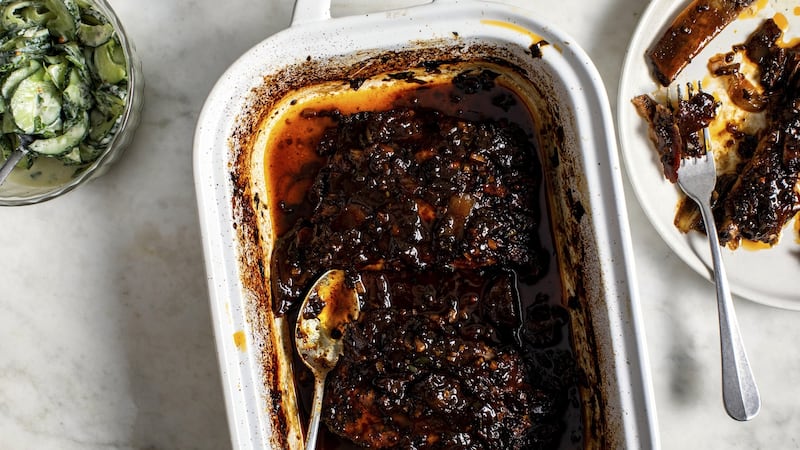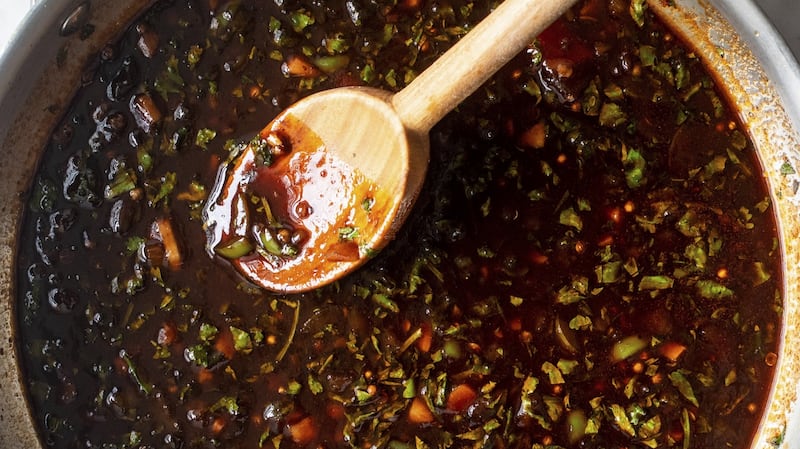There are a few ingredients that I now keep safely up my sleeve and add to my food only as an absolute last resort. I do this because I know that if I were left to my own devices, I would probably use them in every single meal.
I guess there isn’t anything terribly wrong with this per se, but as someone who writes recipes for a living, I am worried about running out of credit with certain ingredients. I know for a fact that I have hit my lemon quota a vast number of times and that I am pretty close to reaching my limit with feta, yogurt and tahini. It is simply too easy to transform a dish with a hurried drizzle, or a sprinkle, or a scatter of one particular kind, that I worry about becoming a culinary con.
Coriander – both the leaves and seeds – is similarly concerning. Nearly all of the cuisines in which I feel at home and which give me infinite amounts of playful pleasure are big on coriander.


My favourite version of cooked Moroccan carrot salad, with lots of cumin, paprika and garlic, gets its spark from freshly chopped coriander, which highlights the sweetness of the carrot and the acidity of the lemon. Similarly, Mexican salsas and salads get their particular accent from coriander and, just as in Morocco, they often rest on the interplay of cumin and a sharp citrus (lime, in the Mexican case). Indian cilantro-mint chutney is a condiment I’d be happy to bathe in. These make it almost impossible for me not to finish a dish with a flourish of chopped coriander or a handful of crushed coriander seeds.
This final gesture is something I routinely do because it really does lift many kinds of dishes to new peaks, whether it’s a simple chopped salad, scrambled eggs, a bowl of steamy rice, a stew or a piece of grilled fish. But my need to show restraint and not exceed my coriander quota means that I now reserve its use to meals in which the cilantro effect is seriously amplified, so that this brilliant herb shows itself in all its glory, right at the core of a dish.
There are two ways in which you can push cilantro into the spotlight. One method, which many cooks revert to instinctively without even knowing they’re doing so, is pairing it with other members in a large family of ingredients called Umbelliferae. This biological grouping may sound obscure, but carrot, parsnip, celery, parsley, dill and cumin all fall under this umbrella and so, unsurprisingly, go well together. My beloved Moroccan carrot salad is so delicious exactly because of the different umbellifers echoing and complementing one another like lines of good poetry.
The other route to take, if you’re looking to maximise the coriander effect, is to use the seeds, the leaves, the stem and, if you can get them, the roots. When added at different stages of the cooking and to different parts of a dish, they can create layers of flavour that underpin the dish and give it lots and lots of character. So many Indian curries are based on this clever layering of warming coriander and cumin seeds (plus a whole bunch of other spices) with the intensity and freshness of the fresh leaves.
This kind of focus on different registers of the coriander flavour is also what I had in mind for these sweet and spicy ribs. Similar recipes often run the risk of being sweet and sticky. Not a bad thing at all with fatty ribs, but the addition of coriander seeds and coriander appearing in a number of ways offers a welcome contrast to a familiar unctuous sweetness. It is a very appropriate opportunity, I find, to bring out an ingredient I am trying to use in a measured and considerate way.
And to Drink …
Sweet-and-spicy dishes like these ribs go well with old reliable, sweet-and-acidic German rieslings, especially those bottles labelled kabinett or spätlese. But plenty of other options will do as well. End-of-summer rosés, particularly those with just a touch of fruitiness, will flatter this dish. I don’t often find many dishes that call for a viognier, but this might be the one. If you prefer reds, look for something with some body and fruit, like a Gigondas from the southern Rhône Valley or other wines made from the grenache grape, whether they come from eastern Spain, the West Coast of the United States or Australia. Good California pinot noirs would be fine matches. Dry sparkling wines might be counterintuitive, but you may be surprised at how versatile they can be. – Eric Asimov

Sweet and spicy ribs with coriander and cucumber
Serves 4
For the ribs
2 tablespoons olive oil
40g peeled and finely chopped fresh ginger
1 small jalapeño, finely chopped, seeds and all
300ml pomegranate juice
30g roughly chopped fresh coriander
75g light brown sugar
75g hot mango pickle, roughly chopped
2 tablespoons tomato paste
1 ½tbs coriander seeds, roughly crushed using a mortar and pestle
1kg baby back ribs (pork loin ribs), cut into 4 equal sections of about 4 ribs each, stabbed a few times on the bony side with a small sharp knife
340g shallots (about four large/eight medium shallots), peeled and left whole or halved lengthwise if large
Kosher salt and black pepper
For the cucumber raita
1 cucumber (about 340g), halved lengthwise, deseeded, then very thinly sliced into half-moons
10g roughly chopped fresh coriander
3tbs sour cream
1tbs fresh lime juice
1tbs olive oil
Method
1. Heat the oven to 150 degrees Celsius.
2. Prepare the ribs: Add the oil to a large skillet and heat over medium-high. Once hot, add the ginger and jalapeño and stir until fragrant, about 1½ minutes. Add the pomegranate juice, fresh coriander, sugar, mango pickle, tomato paste and 1 tablespoon crushed coriander seeds and bring to a simmer. Cook, stirring occasionally, until thickened slightly, about 5 minutes. Set aside.
3. Add the ribs, shallots, ¾ teaspoon salt and plenty of pepper to a 26 x 34-cm roasting pan and toss everything together, arranging the ribs flesh-side up. Pour the sauce on top, wrap tightly with foil, then transfer to the oven to cook for 2 hours.
4. Turn the heat up to 190 degrees Celsius, remove the foil and baste the ribs with the sauce. Cook, basting once throughout, until ribs are a deep chocolate brown and the sauce is sticky, about 25 minutes more. Let cool slightly while you make the cucumber raita.
5. Heat the remaining ½ tablespoon coriander seeds in a small pant over medium-high. Toast until fragrant, shaking the pan occasionally, 1 to 2 minutes. Transfer to a medium bowl along with the cucumber, fresh coriander, sour cream, lime juice, oil, ½ teaspoon salt and a good grind of pepper; toss everything together to combine.
6. Divide the ribs, shallots and cucumber salad among four plates, spooning some of the sauce over the ribs, and serve immediately.









